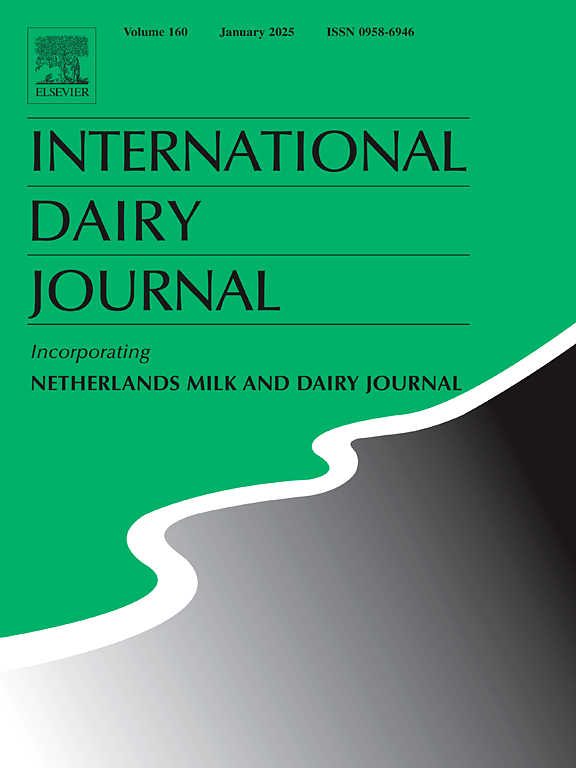Understanding the effect of structure, composition, and particle size on the oral tribology of solid, semi-solid and liquid dairy foods
IF 3.1
3区 农林科学
Q2 FOOD SCIENCE & TECHNOLOGY
引用次数: 0
Abstract
The tribological behavior of foods is a useful tool that can be used to predict the extent of breakdown during oral processing and the overall sensory perception. This study investigated the effects of food structure, particle size and normal forces applied on the tribological behavior of solid (Cheddar, cheese curd, parmesan), semi-solid (cottage cheese, ricotta cheese, yogurt) and liquid (milk, whey protein beverage) dairy products. At first, 1 g of each sample was equilibrated to 22 °C for 30 min and heated up to 37 °C in a water bath for 5 min and mixed with water for 2 min before loading onto the MCR-302 Anton-Paar rheometer for tribological testing using polydimethylsiloxane (PDMS) pins. Different food structures exhibited a clear distinction in tribological behavior i.e., Stribeck curve indicating friction factor (μ) at several sliding speeds. The peak μ decreased with increasing normal forces due to better mixing of lubricant upon particle size reduction and fat release. The μ for milk was 1.5 at 0.01–0.1 mm/s sliding velocity, significantly higher (P < 0.05) than cottage cheese and solid cheeses attributing to higher moisture content. Semi-solids had the second highest μ of 0.54 at 0.1 mm/s of sliding velocity (P < 0.05). This could be attributed to the differences in fat, moisture, and protein contents of the products. This study reveals that structural differences in various dairy products influence tribological behavior which impacts the texture and sensory perception and release of nutrients in GI tract.
了解固体、半固体和液体乳制品的结构、组成和粒度对口腔摩擦学的影响
食物的摩擦学行为是一种有用的工具,可用于预测口腔加工和整体感官知觉过程中的破坏程度。本研究调查了食物结构、颗粒大小和法向力对固体(切达干酪、奶酪凝乳、帕尔马干酪)、半固体(松软干酪、乳清干酪、酸奶)和液体(牛奶、乳清蛋白饮料)乳制品摩擦学行为的影响。首先,每种样品1 g平衡至22°C 30分钟,在水浴中加热至37°C 5分钟,与水混合2分钟,然后加载到MCR-302 Anton-Paar流变仪上,使用聚二甲基硅氧烷(PDMS)针脚进行摩擦学测试。不同的食物结构在摩擦学行为上表现出明显的差异,即在不同的滑动速度下,Stribeck曲线表示摩擦系数(μ)。随着法向力的增加,峰值μ减小,这是由于润滑油在粒径减小和脂肪释放过程中混合得更好。在0.01 ~ 0.1 mm/s滑动速度下,牛奶的μ为1.5,显著高于(P <;0.05),比松软干酪和固体干酪含水量高。在0.1 mm/s的滑动速度下,半固体的μ为0.54;0.05)。这可能归因于产品中脂肪、水分和蛋白质含量的差异。本研究揭示了不同乳制品的结构差异会影响其摩擦学行为,从而影响其质地、感官感知和胃肠道营养物质的释放。
本文章由计算机程序翻译,如有差异,请以英文原文为准。
求助全文
约1分钟内获得全文
求助全文
来源期刊

International Dairy Journal
工程技术-食品科技
CiteScore
6.50
自引率
9.70%
发文量
200
审稿时长
49 days
期刊介绍:
The International Dairy Journal publishes significant advancements in dairy science and technology in the form of research articles and critical reviews that are of relevance to the broader international dairy community. Within this scope, research on the science and technology of milk and dairy products and the nutritional and health aspects of dairy foods are included; the journal pays particular attention to applied research and its interface with the dairy industry.
The journal''s coverage includes the following, where directly applicable to dairy science and technology:
• Chemistry and physico-chemical properties of milk constituents
• Microbiology, food safety, enzymology, biotechnology
• Processing and engineering
• Emulsion science, food structure, and texture
• Raw material quality and effect on relevant products
• Flavour and off-flavour development
• Technological functionality and applications of dairy ingredients
• Sensory and consumer sciences
• Nutrition and substantiation of human health implications of milk components or dairy products
International Dairy Journal does not publish papers related to milk production, animal health and other aspects of on-farm milk production unless there is a clear relationship to dairy technology, human health or final product quality.
 求助内容:
求助内容: 应助结果提醒方式:
应助结果提醒方式:


